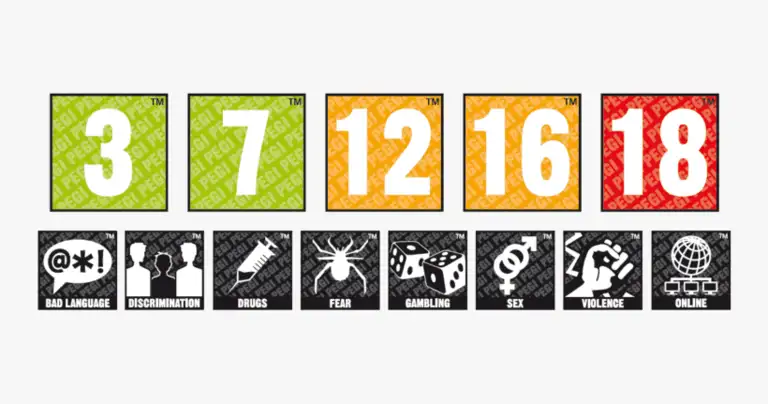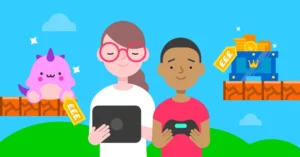How to manage in-game spending
Supporting online money management
Learn about the types of spending found in your child’s favourite online video games along with the risks they might face.
Quick tips
How to manage in-game spending
How to manage in-game spending
 Close video
Close video
Review the available parental controls to manage spending in your child’s favourite game. Popular consoles also have parental controls built-in to the systems they use.
Set controls and then come back to them yearly or as things in their life changes such as their age or available funds.
The best way to understand how a game works is to play them. Ask your child to show you how to play the games they enjoy.
While you play, ask them questions about the different parts, including how the in-game purchases work. This can also give you insight into how much in-game items actually cost.
For older children, involve them in the decision around spending limits. For younger children, make a choice based on what you know about the game.
If your family can’t afford regular allowance or monthly limits, you can work together to make a savings plan using money they earn from odd-jobs or that they get from birthdays.
However, you can also explain that money needs to be used in other places instead of in games if money is tight.
In this guide
- How do children spend money while gaming?
- What parents need to know about in-game spending
- How does in-game currency work?
- The benefits and risks of in-game spending
- Top tips to manage in-game spending
- Supporting resources
How do children spend money while gaming?
On average, 8-17-year-olds spend £38 on in-game spending in a month. Additionally, 55% of parents worry their children feel pressure to spend online. From buying items and boosts to getting the latest expansion pack, costs add up quickly.
In fact, research from Parentzone found that 49% of children and young people believed that online video games were only fun when you spent money.

Difficulty with tracking spending
Children struggle to track spending in digital games. Additionally, they often spend without thinking about it because of how easy it is. It often serves as a form of instant gratification, all according to research from Newcastle University and Loughborough University.
This research also found that there is a type of dissociation when it comes to in-game spending. Oftentimes, children don’t consider the cost and the value of the product before making a purchase. Offline, they might consider how much they have and whether it’s worth it. As such, they tend to overspend without precautions such as parental controls in place.
What should parents know about in-game spending?
Many video games that children play online are free. However, there could be in-game costs or other ways to ‘pay’ such as with data, time and attention.
In ‘free’ online video games, additional purchases help players gain access to new levels, items or skins. While many games allow unpaid routes that could include waiting a set amount of time, children often want to keep up with their friends. So, making an in-game purchase helps them feel included.
It’s important to stay on top of your child’s interests and the types of games they play. This will help ensure you know what financial risks may exist.
The biggest element of spending in-game comes down to microtransactions. They feature in both paid for and free games and encourage players to spend money while playing video games. Purchases might include:
- Unlocking in-game characters
- Unlocking levels in-game
- New skins and accessories
- Loot boxes that offer a (very low) chance to win rare or desirable items.
Quite often, players first get invested in a particular game. Then they learn that to unlock special features to continue playing with or against their friends, they need to pay.
Alternatively, users might need to watch advert videos in order to unlock more power, time or weapons. While they don’t pay with a currency, they do potentially fall risk to data collection or persuasion towards other apps.
Spending real money on virtual items is not new for kids
It’s always been the case that children and young people want the newest and latest to fit in with friends. Whether this is online or off, they still want the latest fashion piece or collectible.
Online, this is well-established. For example, platforms like Habbo Hotel had in-game purchases in the early 2000s. In 2010, the game hit headlines as young people spent real money to decorate their virtual room with the latest furniture. In that case, the virtual goods also had a value and were being stolen and re-sold.
Loot boxes feature in many games though experts liken it to gambling. Typically, users purchase a loot box, hoping it will contain a rare item. However, the probability of this is very low. Just like gambling, though, the hope of getting ‘lucky’ keeps users buying.
- Compulsive spending: children want to win the rare and desirable item. Often, though, they open loot boxes for the experience rather than the item alone.
- Feelings of shame: because transactions are so small, children often lose track of spending until the bill comes and adds it all together. “When players do reflect on their spending, they often recognise it as problematic.”
- Frustration and disappointment: if children don’t get the item they hoped for or repeatedly receive common items. Some young people described the feeling as ‘torment’ or creating ‘rage inside’. Parents described children becoming aggressive.
PEGI (Pan European Game Information) provides age ratings for video games. Additionally, they include content descriptors to identify specific risks.

These descriptors help look beyond age guidance and helps inform parents prior to purchase. This applies to games bought online or in-store.
Cryptocurrency and NFTs continue to increase in popularity. In-game, this might look like users selling virtual items to others.
Additionally, using digital currencies could lead to finance-related harm. This might look like:
- targeted scams
- participating in gambling behaviours
- spending excessively
These harms may have negative impacts on children’s developmental wellbeing.
Explore more about the metaverse or NFTs and cryptocurrency with our guides.
Sending virtual gifts to influencers
On some platforms, users can give streamers monetary gifts. These cost real money take the form of virtual gifts or tokens. Users give them to show their appreciation or to request a a shout out to get recognition on live streams. Some platforms like TikTok limit this to over-18s only in a bid to protect young people.
A BBC report found several cases where influencers asked their fans for gifts. They promised to give a live ‘shout-out’ on their streams or make duets with a user in exchange for the gifts. There were also suggestions that money was exchanged for likes or follows. Some cases saw the sharing of phone numbers or sending of personal messages.
Live streaming platform Twitch is another platform where ‘tipping’ is common.
How the Covid-19 pandemic impacted in-game spending
The Covid-19 pandemic saw a rise in online video games. The popular online gaming platform Steam, for instance, broke its own record for the most players on the platform at once six times during 2020.
Findings from a Barclays Games and Esports report also revealed that the games industry saw the largest increase in spending in 2020, up by 43% compared to 2019.
In the post-lockdown era, some children might still show similar habits and gaming behaviours.

Data from ISFE (Nov 2019) suggested that the majority of young people (6-15) spending money in-game are spending less than £20 a month on average. However, Ofcom research from 2023 shows this at £38 in a month (8-17-year-olds). This could suggest a rise in in-gaming spending among young people.
Rooster Money carried out research with 24,000 children in the UK between April and June 2020. The research showed that video games were more popular than sweets, books and magazines. Similarly, research carried out by Simon-Kucher noted that gamers spent 39% more on gaming during Covid-19 than before.
Children often don’t recognise that when they buy something like virtual cat food, it actually costs real money. Clicking a button on a device feels very different from handing over hard cash. So, younger users often feel that it has no value.
Oftentimes, they might feel pressure to keep up with their friends or others playing the game. As such, spending in-game to unlock the next level or to save a game is incredibly tempting.
The risk of mobile games is the compulsion to play during downtime. Riding the bus home from school, waiting for their friends or even playing while they watch Netflix could lead to more overspending opportunities. This is particularly true with credit cards saved to app stores, devices or games.
Therefore, it’s vital to have regular conversations about spending and set up in-app or device controls.
In July 2019, a US teen made the news when he won $3 million and became the Fortnite world champion. Jaden Ashman from the UK came in second and won almost £1 million. Jaden and his mum often argued over his gaming hobby, especially as his school work suffered. His earnings decreased over the years — from over $1 million USD in 2019 to just $200 USD in 2022.
Many young players aspire to join professional esports teams. In fact, many schools now have esports teams to encourage this interest.
The concern with esports is the amount of time children need to spend playing one video game to become ‘the best’. Other areas might suffer, and their interests remain quite narrow. Additionally, games like Fortnite feature plenty of in-game purchases to give players a boost in their gameplay.
Esports continues to grow with over 496 million esports followers across the globe. Mainstream TV channels even host coverage of esports events such as the League of Legends UK Championships on BBC iPlayer.
How does in-game currency work?
Many of the most popular games that children are playing have their own in-game currency, including Fortnite’s V-bux and Roblox’s popular Robux. They can come in different forms – from gems and coins to energy and strength – all of which can be used to purchase items or unlock levels. See examples of these in-game currencies below.

Benefits and risks of in-game spending
Parents and carers need to teach children and young people how to manage money safely and responsibly. 48% of 13-16-year-olds say they make purchases online. With so many purchases and transactions online, there is plenty of opportunity to help them learn.
However, one of the key challenges of in-game spending is the addictive nature of microtransactions. Gaming platforms use persuasive design to keep people using their product. Children are particularly vulnerable to these features.
It is crucial that parents set games and apps up carefully from the outset to limit potential harms. Create PINs or passwords that only you know and don’t save payment details to accounts they use. Ensure they speak with you if they want to make any purchase online.
Research report, Between Gaming and Gambling, found that many paid reward systems like loot boxes used similar techniques found in regulated gambling. Spinning wheels, flashing lights and ‘near-misses’, aspects of persuasive design, encourage children to spend more.
Furthermore, the items available with chance-based features like loot boxes tend be ones children want most. The hope for a rare item keeps children spending in-game.
Why children want these items
The report listed five reasons children might want to spend real money on virtual items.
To keep up with others
They want the ability to show off the rare skin or item or weapon. It’s a type of “social currency” where how their avatar looks is important to show skill and express themselves.
For an in-game advantage
Weapons, power-ups and passes to reach parts of the game faster are often things users can purchase. To get ahead of others, children often look to a microtransaction to make it happen quickly.
To look a certain way
While some items help users get ahead, others help them look a certain way. Children often don’t want others to see them with the default skin, so they purchase clothes, accessories, actions and more. For some, it could form a collection of theirs as well. Collecting all versions of a particular item is desirable for some children just like collecting action figures or coins offline.
For the prestige of having rare items
Games create “artificial scarcity” that make items more desirable. For gamers and especially young people, having a rare item allows them to show off and feel like one of the lucky ones.
To trade for other items
Some platforms like FIFA and Steam allow users to buy and trade items alongside other players. Rare or desirable items could allow children to trade up for access to other items they want.
Regulation of loot boxes in video games
Loot boxes were the subject of discussion in UK parliament. The Government called for evidence on the dangers of loot boxes and gambling-like behaviours in 2020. This was part of a bid to review the Gambling Act 2005, which does not extend to loot boxes.
However, in 2022, they decided more research was needed, especially to see if in-game gambling behaviours led to issues as adults.
The UK Goverment’s response said that children and young people should not have access to loot boxes unless enabled by a parent or guardian. Additionally, they said all users should have awareness of in-game spending controls and information.
What are gaming companies doing about loot boxes?
Gaming companies continue to address the issue themselves in different ways.
Middle-earth: Shadow of War dropped microtransactions and in-game purchases within months of launching. Users complained that the game was too reliant on in-game spending for players to finish the game.
In 2019, Epic Games replaced “loot crates” with clearer in-game purchases. Instead of mystery items, users would know exactly what they bought.
In 2020, PEGI announced that game publishers would start to provide additional information about in-game purchases of “random items” and specifically about loot boxes.
Games companies recognise there are numerous scams in circulation. As such, they work hard to ensure their platforms are as safe as possible.
However, many scams often take place away from the official platform on a third party app or site. Make children and young people aware of the following to help prevent them falling victim.
Use official channels to trade items
Video gamers might use social media, online forums or other websites to sell their items. Unofficial channels, though, leave users open to greater risk.
Roblox, for example, tells its users that player trading scams exist. However, they cannot enforce deals made between players outside of their official features. Within the platform, users can report scams that the Roblox moderation team can then review and action. All other methods are unofficial and should be treated as suspicious.
Some well-established guidance like ‘if it looks too good to be true, then it probably is’ comes into play here. Learn about common online scams and how to protect children.
Set strong passwords and keep information private
Young people regularly talk about being ‘hacked’. Oftentimes when someone gains access to their account, however, it’s because they left their account open to risk. Setting weak passwords or sharing them with friends can lead to these issues.
Teach them about the information they should keep private and how to set strong passwords. Additionally, make them aware of cyber attacks like phishing and ransomware to help them recognise potential risk.
Explore our guide to creating secure accounts to keep them safe with every new account.
Avoid cheat code misinformation
Games are difficult, particularly when players get to some of the higher levels. As such, there is a market for cheat codes and tricks to help users power-up and move through the game more quickly. These are often advertised and sold via message boards outside of the gaming environment.
Quite often, downloading the ‘cheat code’ also downloads malware or a virus to your device.
Explore our guide to tackling online scams to help children learn to stay safe online.
Tips to manage in-game spending
Before setting controls, discuss them with your child. This is especially true for older children to avoid push back and encourage ownership. Talk about the risks, the actions to take when something goes wrong and being mindful of how much they spend.
Then, agree on limits together. Involve them in the decision-making process to help get them on board. Or provide them an allowance they need to budget if they want to make purchases like these mums: Steph, Sandra and Meena.
Additionally, you might decide to set a monthly limit, require them to use their pocket money or provide them with game credits on gift cards.
Explore some of these controls:
- Epic Games Store
- Electronic Arts app (The Sims, FIFA, Apex Legends)
- The PlayStation Network
- Roblox
- Steam
- Nintendo Switch
- Google Play
Along with partner, Electronic Arts, we surveyed 2000 parents to see how they interacted with their children’s gameplay. We found that 25% of parents played with their child on video games all or most of the time compared to 30% who said they don’t play often or at all.
However, 55% of parents said they feel more connected as a family when they game together. 58% said gaming together provides quality time.
Playing games together helps you connect with your child and show them you’re interested in their digital lives. Moreover, it helps you lead by example. Take the opportunity to teach them healthy behaviours around in-game spending in a casual way.
Regular conversations about their digital life can help children feel better about coming to you when they need support. Have daily conversations about what’s in the news or how they spent their time online. That way when it comes time to talk about in-game spending, the talk won’t feel out of place or like they’re in trouble.
Discussfree versus paid-for games. Help them understand that nothing is really free even if a game is free to download. They may end up paying with their time (such as watching adverts) or their data.
A discussion about loot boxes and microtransactions is particularly important. Explain how they work and the low chance of getting something worthwhile.
Before agreeing to let your child play a game, check the PEGI rating. Check that it’s age-appropriate by it’s age labels. Then check the content descriptors for in-game purchases.
If you don’t feel right about letting them play the game or worry the parental controls are not strong enough, they don’t need to play the game. Use your judgement and be clear to them why they can’t play.
More about money management
Supporting resources
See the latest articles to support children online and find resources to help them make smarter and safer choices online.
 Parent stories
Parent stories
How to help autistic children have safe online interactions: Ailish’s story
Ailish shares her experiences with her neurodivergent and neurotypical sons and interacting safely online.
 Parent stories
Parent stories
How to encourage autistic children to block and report: Anna’s story
Mum of two, Anna, shares how she encourages blocking and reporting with her neurodivergent children.
 Parent stories
Parent stories
How to talk online safety with autistic children: Helen’s story
Mum of two boys, Helen, shares her experience and tips for talking about online safety with her autistic children.
 Parent stories
Parent stories
How I set my child up for responsible gaming online
Ala, mum of two teenagers, shares how setting up parental controls on consoles helped her children have positive gaming experiences.
 News & blogs
News & blogs
What is Kick streaming? What parents need to know
Learn about Kick, a live streaming service similar to Twitch, to help keep children safe.




